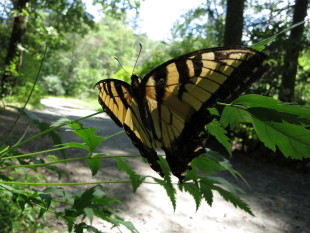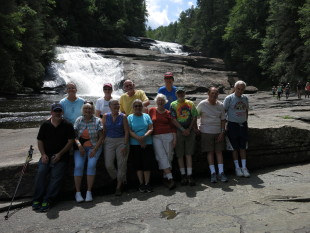By: John Haffner (Thru-Hiker, Ecologist, Juggler)
A number of weeks ago I had a life changing experience. I was excited and nervous for guiding a few days at the Dupont State Forest of Transylvania County, North Carolina. I wasn't nervous because of terrain or because the size of the group I was to guide. I was nervous and excited because I was going to be guiding large groups of mostly deaf individuals.
The 13th Biennial 2015 Deaf Seniors of America Conference in was Asheville. I was to guide 4 groups of 15 people or more with the assistance of a fellow Blue Ridge Hiking Company guide Lori, and an American Sign Language interpreter.
The first day, it was challenging. I didn't know how this was supposed to work. The interpreters were not as early as I was, and there were many people who were wondering where they were supposed to be for their particular tour. I had little to no way to communicate with them. I wished I had at least learned the sign alphabet. I started by writing, "Hi. I'm John! I'm guiding the waterfall hike today." I then asked about how to sign the word "waterfall hike" using a pen and paper as help. A number of people taught me and appreciated my willingness to learn.
The interpreter for the day showed up and everyone was glad that communication could happen a little more easily. Finally, it was time to get going. I noticed upon getting into the bus that this was obviously going to be a quieter group. This was really exciting to me. Normally while hiking in large groups I don't enjoy how noisy it is. I like to go to the woods to enjoy nature's sounds. On the bus I thought about the world that they live in, namely a world of silence. This made me ponder the other cues I get on a hike and tried to put myself in their shoes. I thought about the sights, smells, textures, and even tastes that I could guide them through during the hike. I wanted their experience to be much more than a typical walk in the woods.

When we got to Dupont we stepped outside and someone immediately asked about bug spray. Conveniently located just outside the bus was a group of 3 large sassafras saplings. I pointed at the trees and told my group through the interpreter that this plant would help repel mosquitoes. I crushed a leaf and rubbed it on myself. I then went on to see everyone tell their friends how to use it, and quickly saw the many of the leaves on the tree coming off for everyone to have this natural mosquito repellent. I could not stop the chain of events because of the communication barrier. I felt responsible for that tree. From then on I was careful to explain myself fully.
After we gathered up the whole group we made an announcement about safety, where we were going, and the three spectacular waterfalls we were going to see along the way. The interpreters' arms looked like they were too slow to keep up with our normal speech speed. We made our way and I immediately thought of something I wanted to say. It was hard to get everyone's attention. We learned that waving our hands and gesturing to those that noticed for them to poke their neighbors was the best way to get everyone's attention. It was clear we needed to be more concise with our announcements.
Along the way we showed them the papery feel of beech leaves, the fragrant magnolia fruit, the stickiness of white pine cones, and the taste of wintergreen leaves. All the while I had a great time interacting with all the very friendly folks I was guiding. The communication barrier seemed to improve quite a bit with the skills of the interpreters, me miming out certain things, and the visual aid of the field guides that I brought. It was easy to share my enthusiasm for my love of the outdoors.

The next day, I was excited to find out that we were going to be joined by a man who could not see or hear. His willingness to join us was wonderful and the way that he communicated was very interesting. He had a number of interpreters dedicated to just walking him around by holding his hand or following along by holding onto the interpreters shoulders (think conga line) when the trail got tricky. The interpreters would sign while he was holding onto their hand. When we reached a waterfall or overlook someone would draw what it looked like on his back. This would often take minutes for more complex scenes.
Guiding the deaf-blind gentleman made me dissect even more of the world I know so well. I had to think in terms of only feeling, smelling, and tasting. He got confused by magnolia fruit because they are feel and smell pretty similar to pine cones. After that I felt the need to present many things that are similar side by side for him. I handed him a number of different leaves in succession. I even had him taste a sourwood leaf (which is very sour, hence their name). He grimaced, asked for water and spat it out immediately.

As with all of the trips I guide, I am grateful to the people that I meet and the experiences I have with them. The hikes I lead for the deaf groups have a special place in my heart because of the challenging circumstances and all that I learned by being around this wonderful group of people. The experience definitely opened my eyes todifferent perspectives and inspired me to learn more American Sign Language signs.







Comments
Jim Lilley
February 19, 2017 - 10:25am
What a great story to share. I am a Counselor for individuals who are deaf and/or hard of hearing.
Melisa
January 18, 2018 - 4:43am
It is really great for me to read from the Deaf Hikers. Their tips are nice and I will love to follow them during my tours to niagara falls
Nancy Wyman
June 3, 2020 - 9:15am
Hi I enjoyed reading your article and inspired me so I am motivated and would love to go hiking on Appalachian trail. I am deaf and would like to start deaf group from Michigan next summer. If you or someone interesting to lead us please show me know how we start this program?
Nancy Wyman
Dave Lac
January 20, 2021 - 10:08pm
I am a late deafened person from Mass.
I would like info about any similar future deaf groups who hike the AT please and I would like to take part if poss.